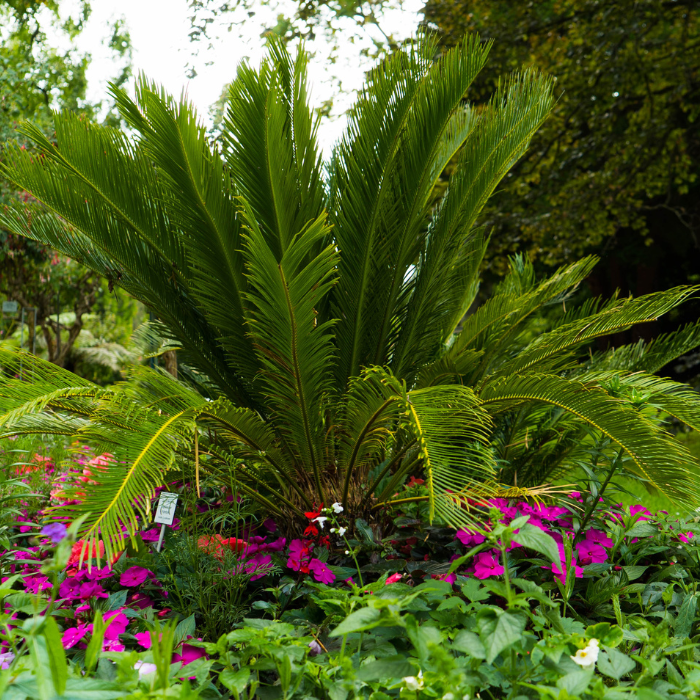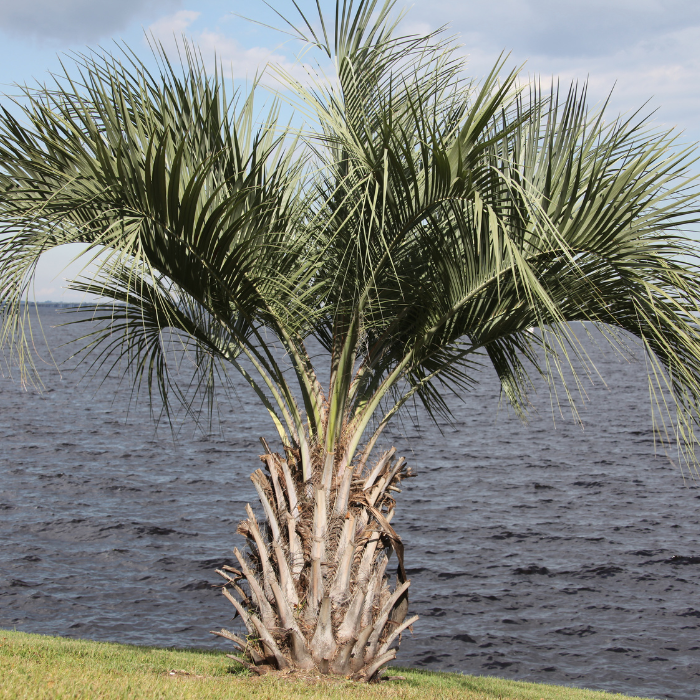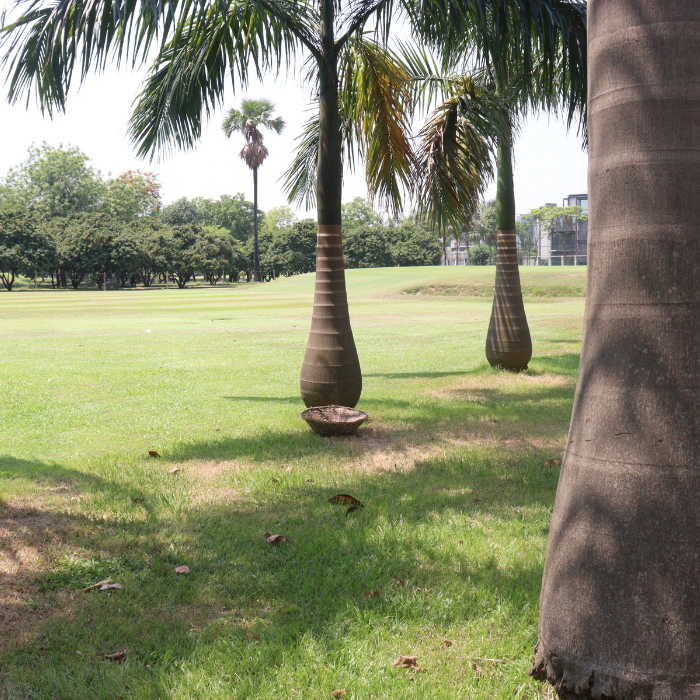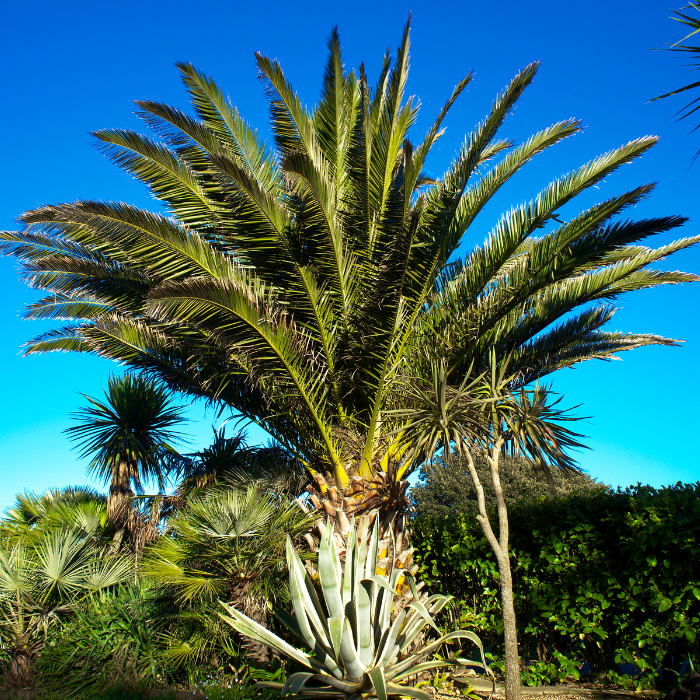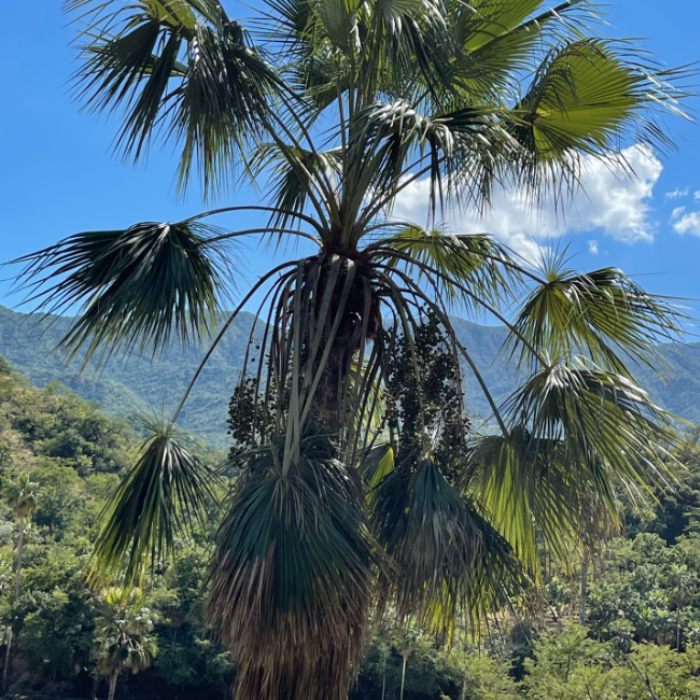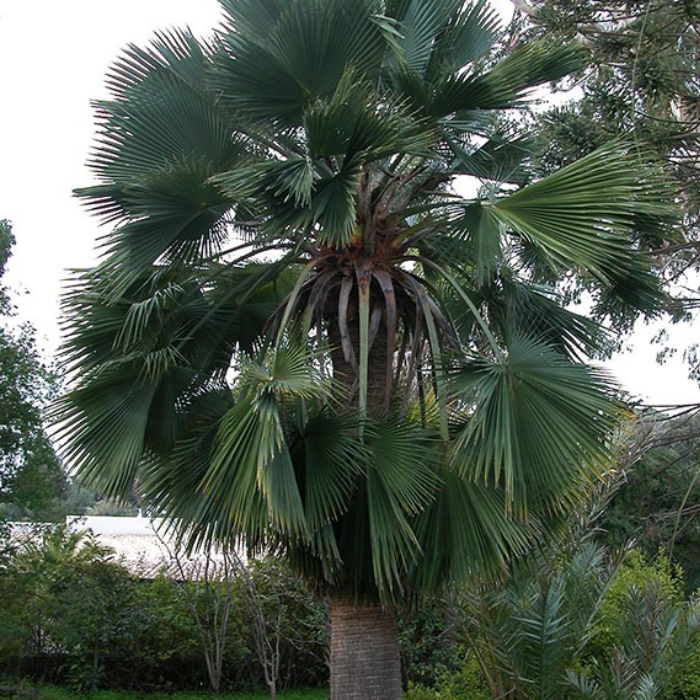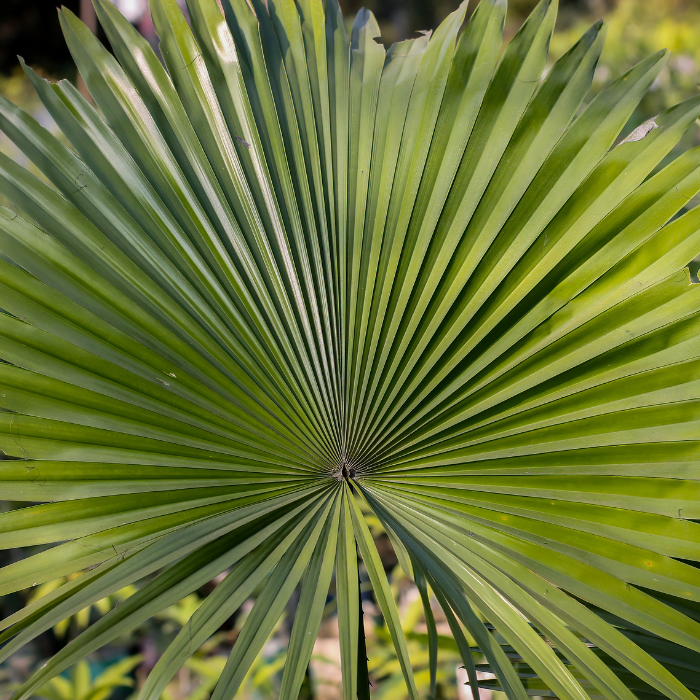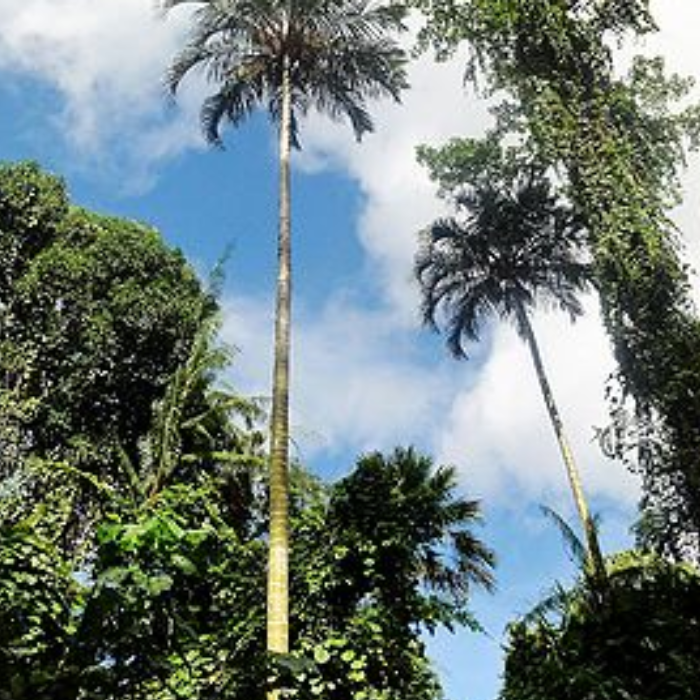
If you dream of creating a tropical paradise in your back garden, a palm is the perfect tree for the job. Palm trees offer a luscious, tropical look that we simply can’t get from plants native to the UK.
Unfortunately, many palm trees need subtropical or tropical conditions to thrive. Yet, luckily for us, some palm species are the right height and hardiness for our UK conditions.
Join us as we explore 75 types of palm trees, some petite enough to grow indoors and others hardy enough to stay out in your garden!
Small Palm Trees
1. Sago Palm (Cycas revoluta)
The Sago Palm is one of the most well-known palm species in the UK, but you won’t find it outdoors! Instead, we like to keep Sago Palms in our homes. They’re easy to look after and have beautiful, feathery foliage that brings vibrance to any room.
2. Pygmy Date Palm (Phoenix roebelenii)
The Pygmy Date Palm is a diddy species that reaches a maximum height of 3 metres. This is one of the most popular palm varieties, not only because its size means it can be grown both indoors and out, but because it also has attractive, verdant green pinnate leaves that arch gracefully.
3. Cat Palm (Chamaedorea Cataractarum)
The Cat Palm grows up to 2 metres outdoors and 1 metre indoors. You can identify a Cat Palm by its thin green stems, and it doesn’t have a trunk, which is a big giveaway! If your Cat Palm has the right quantities of sun and water, it’ll reward you with beautiful yellow blooms in late winter or early spring.
4. Bottle Palm (Hyophorbe lagenicaulis)
The Bottle Palm is short and stumpy, growing 3 metres tall and sporting a wide trunk. You can grow a Bottle Palm indoors in the UK (if you have the space!). Place it near a south or west-facing window to give it at least several hours of sunlight, and ensure you protect it from chilly temperatures. Anything below 27°C and your Bottle Palm will complain!
5. Pindo Palm (Butia odorata)
The Pindo Palm is a delightful choice for UK gardeners as it’s a slow-growing, medium-sized variety that grows up to 5 metres indoors. Its glorious fronds and ornamental fruit create tropical ambience in a home, and its tolerance to partial shade makes it better suited to the UK climate than most palms.
6. Mazari Palm (Nannorrhops ritchiana)
The Mazari Palm isn’t really a tree, as it has no trunk. Instead, it looks more like a shrub or bush. It has silver-blue or silver-green fronds, making it a beautiful plant to own. Luckily, it’s one of the hardiest varieties, meaning it may withstand milder coastal regions in the UK.
7. Everglades Palm (Acoelorrhaphe wrightii)
The Everglades Palm is another hardy variety, growing well in a range of soil types, showing strong drought tolerance, and handling some shade as well as full sun. However, if you’re considering growing an Everglades Palm in your UK garden, you’ll need to bring it in for winter as this plant will only survive in temperatures above -6°c.
8. Lady Palm (Rhapis excelsa)
The Lady Palm grows up to 4 metres tall in prime conditions and has gorgeous, cane-like stems that almost remind us of bamboo. This palm is shade-tolerant and can handle temperatures from -5°C to 37°C, so it’s a prime choice as a houseplant for a UK home.
9. Seashore Palm (Allagoptera arenaria)
The Seashore Palm is a desert fruit tree originally from Brazil. This plant is perfect if you’re tight on space, as it only grows to 1.8 metres and is highly adaptive to coastal areas, hence the name. In its native region, the Seashore Palm will grow in a bed, border, or even a container, but unfortunately, it doesn’t appear in other countries very often.
10. Red Leaf Palm (Chambeyronia macrocarpa)
The Red Leaf Palm, also known as the Flame Thrower Palm, was given its name because, when new leaves appear, they tend to sport vibrant shades of scarlet, purple, orange, and red! In its natural habitat, the Red Leaf Palm can grow to 5 metres tall.
11. Triangle Palm (Dypsis decaryi)
The first question most people ask about the Triangle Palm is, “How did it get its name?” That’s until they see it, anyway. The Triangle Palm is a medium-sized tree with a distinctive triangular shape due to how its fronds protrude from the trunk at a 120° angle.
12. European Fan Palm (Chamaerops humilis)
The European Fan Palm first came from Crete but is now grown in European gardens. This is considered a “bushy” palm as it typically spreads just as broad as it grows tall – around 3 metres tall and 2.5 metres wide. It’s also a hardy plant, capable of growing in poor, stony soil and various weather conditions.
13. Dwarf Majesty Palm (Ravenea hildebrandtii)
The Dwarf Majesty Palm would likely be in most people’s top 5 short palm trees. Why? Mainly due to its elegance. It has a single, slender trunk and wide, arching fronds that would suit a medium or even small-sized garden.
14. Christmas Palm (Veitchia merrillii)
The Christmas Palm is another popular miniature palm, known mostly for its fruit that matures at Christmas time. One of the most fascinating qualities of the Christmas Palm is its ability to self-clean – as the old leaves become mute, they die off, and the plant sheds them. This makes the Christmas Palm a worthy garden plant, as you can be sure it’ll always look its best!
15. Lipstick Palm (Cyrtostachys renda)
The Lipstick Palm gains its name and its other common name, “Red Sealing Wax Palm,” due to the incredible colour of its stems – green on the lower half, almost resembling bamboo, but with a red crown shaft. This gives the striking appearance of a tube of lipstick. The Lipstick Palm isn’t fully hardy in the UK, but it makes an excellent houseplant.
16. Arikury Palm (Syagrus schizophylla)
The Arikury Palm is another small palm variety that boasts verdant green fronds. It’s unique from many of the palms on its list because its leaves have distinctive toothed stems. The Arikury Palm’s form makes it a highly popular specimen tree, and its compact shape (1.8 m tall) means it’s ideal for planting in a small or medium-sized garden.
17. Dwarf Sugar Palm (Arenga engleri)
This plant is a classic garden plant if you’re going for a tropical look. Rather than a large, thick trunk, it has a clumping growth habit that almost makes it look like a shrub. The Dwarf Sugar Palm can handle lower temperatures, even down to -4°C, so it can survive in the UK if protected during the winter.
18. Dwarf Palmetto (Sabal minor)
This tree is one of the world’s hardiest palms, able to cope with many living conditions and -18°C temperatures. The Dwarf Palmetto grows slowly and only reaches 1.5 metres tall at full maturity, so it’s by far one of the best palm trees for UK gardeners.
19. Needle Palm Tree (Rhapidophyllum hystrix)
The Needle Palm Tree is similar to the Dwarf Palmetto in many ways. It’s another extremely hardy palm variety that’s able to manage temperatures down to -20°C, and it doesn’t mind nutrient-poor soil. It’s also a slow-grower, reaching the same 1.5 metre height in maturity. The main difference is that the Needle Palm has a small, thick trunk, whereas the Dwarf Palmetto tends to be trunkless.
20. Chinese Fan Palm (Livistona chinensis)
The Chinese Fan Palm originates from Asia and the Far East and, as a result, requires lots of sun exposure to reach its full potential of 9 metres. This plant may look attractive at first glance, but it can sometimes become a weed – it’s even considered invasive in the Florida wetlands and Hawaii.
21. Cayman Thatch Palm (Coccothrinax proctorii)
The Cayman Thatch Palm’s symmetrical crown and medium size (up to 6 metres) make it a top choice for a small or medium-sized tropics-inspired garden. Its leaves have the fan shape you expect to see in a tropical palm, but they protrude out from the trunk in a way that creates a rounded or triangular crown, giving this tree a slight twist of uniqueness.
Larger Types of Palm Trees
22. Coconut Palm (Cocos nucifera)
The Coconut Palm is famous for one particular reason – can you guess it? It produces coconuts, of course! It has a single, solitary stem that stands proud at 30 metres tall. You’ll likely get around 75 fruits from the tree per year in ideal conditions, but it certainly won’t if it’s left outside in the UK. Coconut Palms need to grow indoors in a humid, hot room in the UK.
23. Date Palm (Phoenix dactylifera)
Just like the Coconut Palm, the Date Palm is known for its delicious fruit. This tree produces an abundance of dates, clustered into bundles that can simply be pulled off the stem in late summer, from August to September. Date Palms grow to around 23 metres high in Iraq, their native region.
24. Oil Palm (Elaeis guineensis)
Many will have heard of palm oil, but did you know it came from the Oil Palm tree? Palm oil is produced by pressing the juicy red berries the tree produces. This creates a vegetable oil many of us use in cooking. As palm oil is in around 50% of packaged goods in supermarkets, this tree has much economic value.
25. Queen Palm (Syagrus romanzoffiana)
Unlike the Oil Palm, the Queen Palm is purely a showy plant. It’s considered an extremely stylish tree that provides year-round interest as it keeps its leaves, even through winter. Queen Palms love sun and heat and will grow to 21 metres in prime conditions. This renders it difficult to grow in the UK, as we have trouble mimicking this climate.
26. Peach Palm (Bactris gasipaes)
Peach Palms produce edible red (sometimes yellow or orange) fruits that have many uses in cooking, such as for pulp flour, cooking oil, and to produce heart-of-palm, a vegetable that is commonly used in salads, dips, and as a vegan meat replacement. This tree can grow outside in the far south of the UK, but it’ll struggle if you live anywhere else.
27. Royal Palm (Roystonea regia)
You’ll most commonly see the Royal Palm growing on the streets of Hawaii, southern California, Florida, and Texas. Unfortunately, you’re unlikely to see it here in the UK unless it’s in a conservatory or greenhouse. It’s a pretty tolerant tree, managing to live in salty air and in periods of drought, but it desperately needs the sun and humidity of the tropics and subtropics.
28. California Fan Palm (Washingtonia filifera)
The California Fan Palm might not be one for the garden, but it is beautiful. At 18 metres tall, this lofty tree has a thick, columnar trunk with a crown of feathery fronds. The California Fan Palm is easy to identify because, as its old leaves die and turn brown, they collect just under the crown, making the tree look like it’s wearing a skirt!
29. Areca Palm (Dypsis lutescens)
You’ll likely have heard of the Areca Palm if you’re into houseplants. Areca Palms are readily available in garden centres around here, as they’re a popular plant due to its unkillable nature. While they may need a little fertiliser occasionally, these plants are pretty easygoing.
READ NEXT: 10 Unkillable Houseplants That Don’t Need Much Love!
30. Mexican Fan Palm (Washingtonia robusta)
Mexican Fan Palms show off the characteristic palm look, with the leaves forming a crown at the top of the tree. This palm often gets mistaken for the California Fan Palm due to their similar appearance. However, the Mexican Fan Palm has a much narrower trunk (up to 35.6 cm in diameter compared to the California Fan Palm’s 90 cm).
31. Canary Island Date Palm (Phoenix canariensis)
The Canary Island Date Palm is grown predominantly as an ornamental plant in parks but also works perfectly in a large garden. It grows to 20 metres tall in the right conditions, yet won’t get near this in the UK. It can grow here in a sheltered spot with full sun, but it’ll need winter protection, that’s for sure!
32. Foxtail Palm (Wodyetia bifurcata)
Foxtail Palms are subtropical plants from Austrailia’s rocky northeastern peninsula and scrublands. They gained their name from the shape of their fronds, which arches in a way that makes it look like a fox’s tail. Because of this, it’s highly unlikely we’ll see it around unless we take a trip to the US or Australia!
33. Caribbean Royal Palm (Roystonea oleracea)
The Caribbean Royal Palm should be your go-to if you ever need a tall tree to flank a path or street. This tree stands at an impressive 40 metres tall, with a tuft of up to 22 leaves that forms only at the top of the tree. The tree is particularly beautiful in summer when it produces a profusion of white flowers.
34. Bismarck Palm (Bismarckia nobilis)
Looking for a palm that’s unlike any other? The Bismarck Palm may be just the one for you. This palm instantly grabs people’s attention, with a 7.5-metre spread and a 6-metre height. Its stout trunk and blue fronds make it an aesthetically pleasing ornamental plant that catches the eye!
35. Windmill Palm (Trachycarpus fortunei)
The Windmill Palm is a big tree that grows up to 20 metres over 60 – 70 years. This is the best Palm species to grow in the UK because it’s the hardiest to our weather conditions. It’s originally from Northern China, so it doesn’t mind sun, shade, or even heavy rain!
36. Sugar Palm (Arenga pinnata)
Another solitary palm, the Sugar Palm, is a medium-sized tree that grows up to 20 metres. This tree is important in its native region, tropical Asia, because its timber is perfect for construction, including for posts, flooring and beams. The sap is also harvested to make “gur” sugar, hence this plant’s name!
37. MacArthur Palm (Ptychosperma macarthurii)
The MacArthur Palm has long, slender trunks with a dense crown or up to 13 fronds, giving this palm the aesthetics of what most of us imagine a palm tree to be. This palm is easy to identify from the rest because it doesn’t only have one stem – in fact, it tends to have many! The stems sport a whitish colour and are spotted with dark rings.
38. Carpentaria Palm (Carpentaria acuminata)
If there ever was a plant that loved the sun, it’d be the Carpentaria Palm. This is a fast-growing tree that needs full sun to flourish. The Carpentaria Palm is known as one of (if not the) fastest-growing palms. Under the right conditions, it could grow up to 1 metre per year. Eventually, it can reach heights of 30 metres! It’s safe to say this isn’t the ideal indoor plant.
39. Solitaire Palm (Ptychosperma elegans)
The Solitaire Palm is a slim palm species native to Queensland, Australia. It gains its name from its solitary stem, which typically grows no broader than 10 cm. This palm can grow to 10 metres, but it doesn’t tend to exceed 6 metres. It isn’t hugely fussy about its growing conditions but won’t do well in a fully shaded spot.
40. Pritchardia Palms (Pritchardia spp.)
Pritchardia Palms, also known as “Loulu palms,” are a group of single-trunk palms native to Hawaii. The three most common species are:
41. Prichardia hillebrandii: This species is often referred to as Loulu in Hawaii. It’s recognised for its distinctive silver-green leaves and can reach heights up to 7.6 metres.
42. Prichardia pacifica: This species, also known as the Fiji Fan Palm, is native to Fiji but has been cultivated and is sometimes found in other tropical and subtropical regions. It has large, fan-shaped leaves and is popular for landscaping in tropical and coastal areas.
43. Prichardia martii: This species, known as the Martii Fan Palm, is native to the Hawaiian Islands. It is a smaller palm, typically growing up to 3 metres in height. The leaves are green and fan-shaped.
44. Red Latan Palm Tree (Latania lontaroides)
The Red Latan Palm Tree is a tree that has declined in recent years. It’s native to the island of La Réunion but has recently been named endangered due to its rapidly reduced habitat. Despite its endangered status, Red Latan Palms are still traded as ornamental plants as people love the plant’s red juvenile leaves.
45. Fishtail Palm (Caryota mitis)
Fishtail Palms are distinctive plants, possessing shiny green leaves with jagged edges. When you look at it, it’s no wonder it was named the Fishtail Palm! Fishtail Palms make exceptional houseplants due to their decorativeness but will need well-drained soil and filtered (not full) sunlight.
46. Sylvester Palm (Phoenix sylvestris)
The Sylvester Palm tree is a relative of our 30th palm on this list, the Canary Island Date Palm. It’s similar in that it also produces dates, but this is typically shorter, with some varieties only growing to 4 metres and others 15 metres. If you look at a Sylvester Palm, you’ll quickly notice the scales on its trunk – it has a diamond-shaped pattern, much like a pineapple.
47. Yellow Latan Palm (Latania verschaffeltii)
Yellow Latan Palms are from Rodrigues Island in the Indian Ocean. You can identify these plants easily, particularly when they’re young, as the stems connecting the leaves to the trunk (called “petioles”) are a lively shade of yellow. Unfortunately, there aren’t many of these plants left – around 500 in their native region. However, they are available commercially as ornamentals.
48. Blue Latan Palm (Latania loddigesii)
The Blue Latan Palm is another Latania, but this time in blue form! While the tree only grows 8 metres tall maximum, this plant’s leaves get everyone talking. Gigantic, blue, fan-shaped leaves protrude from elongated 1.8-metre flower stalks. This show-stopping plant is perfect to add some palmy pizazz to your garden.
49. San Jose Hesper Palm (Brahea brandegeei)
San Jose Hesper Palms are slow-growing trees that grow to around 18 metres in their lifetime. Due to its native region of Baja California, this palm has a high drought tolerance, making it ideally suited to arid landscapes, but is susceptible to damage caused by frost. Because of this, we suggest planting a San Jose Hesper Palm in a conservatory, greenhouse, or city garden (with frost protection).
50. Alexander Palm (Archontophoenix alexandrae)
The Alexander Palm is a textbook tropical palm plant. This tree is simplistic yet sophisticated, with a long, thin trunk and elegant arching fronds at the top of the tree. This palm will want full sun to thrive, but it’s not fussy about soil types – give it nutrient-rich or poor soil; it doesn’t mind.
51. Senegal Date Palm (Phoenix reclinata)
Senegal Date Palms are relatively frost and shade-tolerant but prefer full sun and warmer temperatures. While this is a strong grower in UK summers, it’s difficult to grow outdoors in the UK in winter, so stick it in a conservatory or greenhouse. When it’s young, it also makes an excellent windowsill plant.
52. Champagne Palm (Hyophorbe indica)
With a name like “Champagne Palm,” you expect splendour, right? Well, the Champagne Palm doesn’t disappoint. Given its name due to its bottle-shaped trunk, this is a great plant for indoor growing. It grows around 10 metres tall and has a small, slender trunk with captivating, feathery fronds. When choosing the Champagne Palm, you can pick a green or red-stemmed variety. However, they’ll look the same once they mature.
53. Real Fan Palm (Hyphaene petersiana)
If you’re looking for a large palm tree with a twist, you’re in for a treat with the Real Fan Palm. These trees grow to 20 metres tall in optimal conditions (but most often stop at 7 metres), and their leaves extend up to 2 metres long. The leaf stems stick out at random angles, giving a mad scientist-like appearance – this quality is where the tree’s uniqueness lies.
54. Bangalow Palm (Archontophoenix cunninghamiana)
The Bungalow Palm is another 20-metre tall tree with massive evergreen fronds – they grow to around 4.5 metres long each! The meaning behind this tree’s name is interesting – “bungalow” means “water carrying basket” in Aboriginal. It was given this name because the Aborigines used to fashion the crown shaft into a watertight container, using the plant’s petiole as a handle.
55. Traveller’s Palm (Ravenala madagascariensis)
Traveller’s Palms differ from the vast majority on this list because of their leaves – they have large, paddle-shaped leaves on long stalks, giving them a similar appearance to banana plants. Why? Well, this tree is not a palm at all. In fact, it belongs to the Bird of Paradise family!
56. Puerto Rican Thatch Palm (Coccothrinax alta)
The Puerto Rican Thatch Palm has silver-green fronds that sway gently in the breeze, providing a hint of tropical comfort all gardens desire in a tropics-inspired garden. This palm is hardy, with good resistance to cold temperatures and salt-laden coastal winds, making it an ideal choice for British gardens.
57. Manila Palm (Veitchia merrillii)
The Manila Palm, scientifically named Veitchia merrilla, is a tropical gem that can handle UK temperatures. Its glossy, feather-like fronds and slender trunk will create a glorious shady spot in your garden. However, you’ll need to protect it over winter, bringing it into a greenhouse or preferably a toasty conservatory.
58. Parlour Palm (Chamaedorea elegans)
We love Parlour Palms in the UK. You’ll see these in most garden centres and even some supermarkets – they’re widely available. We bestow so much love on this plant because of its small, 1 – 1.5 metre indoor height, collection of slim stems topped with dainty leaves, and adaptability in windowless rooms.
READ NEXT: 21 Best Plants for Rooms Without Windows
59. Chilean Wine Palm (Jubaea chilensis)
The Chilean Wine Palm has an imposing, stout trunk and a crown of arcing fronds. Simply put, this tree demands attention. Unique among palms, the Chilean Wine Palm produces edible, wine-like sap and grows slowly, making it a fascinating focal point in any garden.
60. Kentia Palm (Howea forsteriana)
The Kentia Palm is a distinguished palm species renowned for its grace and adaptability. Its lean trunk and luscious fronds evoke a sense of timeless elegance. This palm is the perfect versatile, low-maintenance, and helpful houseplant, as it removes many impurities from the air.
61. Cuban Petticoat Palm (Copernicia macroglossa)
The Cuban Petticoat Palm’s defining feature is its graceful “petticoat” of dead fronds that encircle its trunk, creating a natural sculptural look. This palm is highly resilient to drought and can thrive in various soils, but it’s not the biggest fan of the cold. Bring it in or protect it over winter, however, and it should be fine.
62. Guadalupe Palm (Brahea edulis)
Guadalupe Palms are native to Guadalupe Island in Mexico and haven’t strayed far from here over the years. Because of this, you’re unlikely to find one on offer around here. The Guadalupe Palm has a solitary trunk that grows to about 12 metres tall, with a canopy of fronds that sport a blue-green colour and fan out in a 5-metre spread.
63. Silver Saw Palmetto (Serenoa repens)
The Silver Saw Palmetto is a palm endemic to the West Indies but is now widely grown in much of the Atlantic southeast coast of North America. It’s believed to have many advantageous properties as a medicinal plant, with some evidence suggesting that it may have positive effects on some forms of alopecia.
64. Texas Sabal Palm (Sabal mexicana)
The Texas Sabal Palm is a stocky plant with a thick trunk almost 1 metre wide. It has substantial, fan-shaped leaves in a blue-green hue that produce a dense, rounded crown. The Texas Sabal Palm is a slow-growing tree that provides a wonderful food source for wildlife when its dark purple fruit appears. As it’s relatively winter hardy, it will likely do okay in mild winters.
65. Blue Hesper Palm (Brahea armata)
The Blue Hesper Palm, also commonly known as the Mexican Blue Palm, is a popular ornamental plant sold worldwide, including the UK. In actuality, it’s so well-recognised in the UK that it received the Royal Horticultural Society’s Award of Garden Merit. Place this plant in a spot that gets full sun or partial shade, and only protect it from frosts when they’re expected to dip below – 10 °C.
66. Yatay Palm (Butia yatay)
The Yatal Palm produces edible fruits enjoyed in its endemic regions of southern Brazil, northern Argentina, and Uruguay for their delectable, sweet flavour. This plant’s scientific name comes from the local Brazilian word for “thorny thing,” potentially given due to the spikes on the plant’s petiole margins.
67. Puerto Rico Royal Palm (Roystonea borinquena)
The Puerto Rico Royal Palm stands out due to a single defining feature – its fruit. It produces a colossal bundle of fruit that boasts a green-yellow colour when immature before turning brown-purple as they ripen. These fruits are an invaluable food source for native birds, particularly pigeons, who massively aid this plant’s reproduction through seed dispersal.
68. Bamboo Palm (Chamaedorea seifrizii)
Bamboo Palm loves to grow in disturbed forests in its native region, Mexico and Central America. It’s commonly grown as a hedge plant in Florida but has since been found to have escaped cultivation. It’s also often called the “Reed Palm” due to its multiple upright stems.
69. White Wanga Palm (Pigafetta filaris)
If you ever visit the gardens and forests of Maui, Hawaii, you’ll likely spot the White Wanga Palm, typically referred to by its scientific name, Pigafetta filaris. This tree grows exceptionally fast in humid, hot conditions and flourishes in any soil type.
70. Coconut Queen Palm (Syagrus x costae)
The Coconut Queen Palm is a hybrid species with many verdant green leaves. Its trunk is short, and its leaves grow from the base to the top of the plant, creating an amazing arcing shape. This feature makes it a top choice as a specimen plant.
71. Cabbage Palm (Sabal palmetto)
The Cabbage Palm is a rustic tree loved for its unkempt appearance, particularly in Florida, where it’s named the state tree. The Cabbage Palm also appears on the state flag of South Carolina. Unfortunately, this tree is susceptible to Ganoderma butt rot and Thielaviopsis trunk rot, which have reduced the numbers significantly over recent years.
72. Toquilla Palm (Carludovica palmata)
This palm is also colloquially known as the Panama Hat Palm, as its leaf shape resembles a Panama hat. While commonly called a palm, the Toquilla Palm is actually a palm-like monocotyledon plant, a family of grass-like flowering plants.
73. African Fan Palm (Borassus aethiopum)
The African Fan Palm is a tall tree – one of the tallest on this list – growing up to 25 metres. It has a chunky, rounded trunk with deep gashes and produces show-stopping yellow flowers, but only after 40 years of maturity.
74. Quindío Wax Palm (Ceroxylon quindiuense)
If you thought the African Fan Palm was tall, wait until you hear about this one. The Quindío Wax Palm is the tallest of its kind in the world, reaching an incredible 60 metres. To find this plant in its native habitat, check out the forests of the Andes; you’ll find the Quindío Wax Palm in abundance.
75. Caranday Palm (Copernicia alba)
The Caranday Palm boasts beautiful, creamy white flowers in spring in various areas of South America, to which it is endemic. It’s a cold hardy plant that will survive lows of -4°C, but asking any more of it than this will likely lead to plant disaster!
FAQs
Can I plant a palm tree in my garden UK?
Yes, you can plant certain palm trees in your garden in the UK. However, some palm species are better suited to the UK climate than others. Some of the best palm varieties for UK growing are the Windmill Palm, Needle Palm, and Dwarf Palmetto.
What is the easiest palm tree to look after?
The easiest palm tree to look after is likely the Windmill Palm (Trachycarpus fortunei). Windmill Palms are well-suited to the UK’s climate because they are relatively cold-hardy and can withstand cold temperatures down to -15°C when established.
What is the most hardy palm tree?
The Needle Palm (Rhapidophyllum hystrix) is often considered one of the most cold-hardy palm trees. It is native to the southeastern United States and can tolerate extremely low temperatures, making it well-suited for regions with harsh winter climates.
